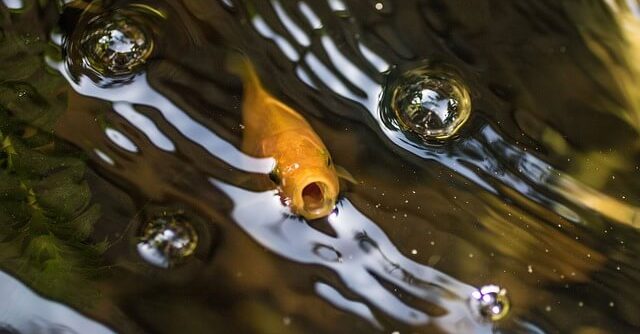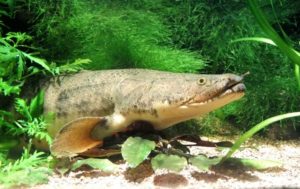Sharing is caring!
We’ve all seen the bubbles rising up in fish tanks. You may even have an air stone in your tank right now. Perhaps you have the back of your tank as a bubble wall. Popular back in the day was those little treasure chests that would randomly open, allowing bubbles to rise to the surface. But what really is the purpose of all these bubbles. They look cool, right? Well yes, but they do so much more than just make your tank look fancy. In fact, they have a very important role in your aquarium.
Why Aeration is important
It’s all about the surface of your water. In some aquariums with low flow and no air pump running, you may see that the water surface is still and flat. In nature, there are variables that prevent this from happening, such as water currents and wind. Having aeration in your tank will help break up that surface tension and help mimic the natural effects of mother nature.
But it’s more than just mimicking nature, breaking up the surface tension plays a role in the health of your fish. Specifically, your fish’s ability to breath. As we all know fish absorb oxygen right from the water. Let’s ignore Lungfish for the purpose of this article. They do this by passing water through its gills where oxygen (O2) is absorbed and passed onto its bloodstream. Much like how our lungs pull in air where the O2 is absorbed into our blood. After we take our breath, we exhale carbon dioxide (CO2). Fish do the same. As O2 is removed from the water and CO2 is added, there will eventually be a deficiency and your fish will no longer get the O2 it needs from the water. This problem is resolved by the process of the gas exchange.
Gas Exchange
A gas exchange occurs when one gas is exchanged for another. When we are talking about aquariums, we are discussing carbon dioxide (CO2) in exchange for oxygen (O2). This vital exchange of gases occurs at the surface of your water. Water will naturally absorb O2 from the air and CO2 will be released into the air resulting in a constant cycle of replenishing the O2 levels of your aquarium. However, in stagnant waters, this gas exchange is dramatically reduced.
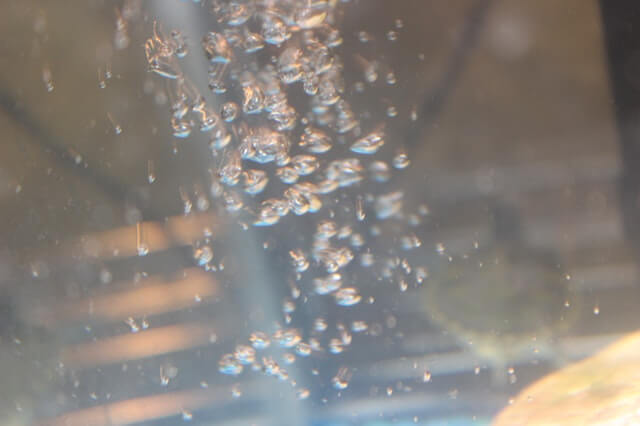
In comes the often-heard phrase, surface agitation. By agitation the surface of the water you are both, breaking up the surface tension and also creating a larger surface area. There are several ways to create surface agitation and it doesn’t have to be with an air pump. In many cases, the water cascading down from a filter will provide enough agitation to aid in the gas exchange. You may also have your return lines from a canister filter or a sump creating enough of a current to prevent stagnation. If not, you can always add a power-head to your setup.
In larger tanks, a hang on the back filter, or HOB filter, generally won’t agitate the surface enough. Perhaps your pumps don’t provide enough of a current, or maybe you have a set-up where having higher currents aren’t ideal for the species of fish you keep. This is where an air stone, bubble wand, or bubbling decoration wins the day. Pumping air bubbles into your tank is a cheap and easy alternative. And yes, it can add to the visual appeal of your tank. Try to place the bubbles in an area where the surface isn’t getting much movement.
Myths about aeration
I’d like to dispel a myth that I hear over and over again within the fishkeeping hobby. The bubbles themselves do not add oxygen to your water column. Well, at least not in any measurable way. I’ve seen people put air stones under their filter intakes hoping that the bubbles being shot across their tanks will help spread out this oxygen. Don’t do this. All you’ll end up with is a burned-out motor or impeller. At the very least it will shorten the lifespan of your filter.
The entire purpose of the bubbles is again, to break up the surface of your water. You’re not going to diffuse the air to the point where you are separating the oxygen molecules and forcing a gas exchange within the water column.
How temperature affects the gas exchange
The greater the temperature the less dissolved oxygen will be present in your aquariums water column. The less oxygen, the greater your need to promote the gas exchange. Not only will a warmer tank have less oxygen available but it will also increase the metabolism of your fish. The greater your fish’s metabolism the faster it will consume oxygen. See where I’m going here?
Fish require 5-6 parts per million (ppm) of oxygen in their water. At a water temp of 64°F degrees (18°C), water can hold a maximum of 9.5ppm, at 74°F (23°C) that number drops to 8.5 ppm. At a higher temp of 86°F (30°C) water can only hold a maximum of 7.5 ppm of oxygen. These numbers are the maximum ppm of oxygen that water can hold, not a good representation of what your water is actually holding. The greater the number of fish that you keep, the less oxygen that will be available.
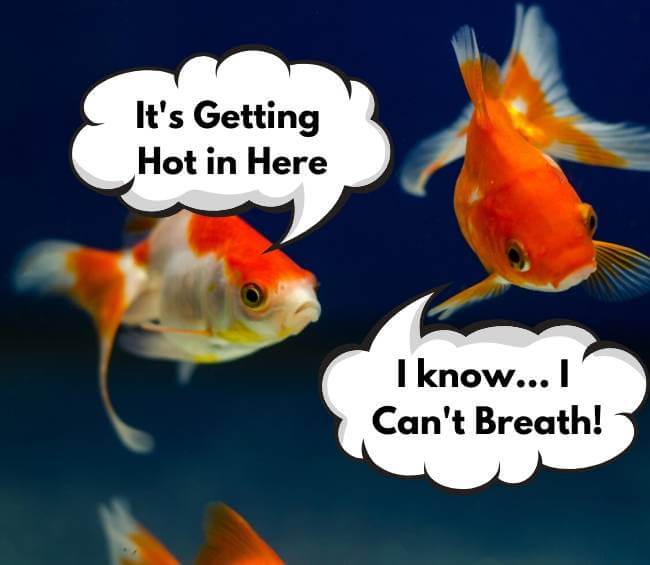
Now I’m not saying that colder water is better than warmer water. The temperature of the water should be dictated by the requirements of the species of fish that you keep. However, the warmer the water, the greater the need for aeration to aid in the gas exchange.
Effects on water chemistry
The temperature of your aquarium can have an effect on the chemistry of your water as well. At higher temps, your PH will read higher than at lower temps. The temp won’t actually change the acidity or alkalinity levels but can instead, alter the readings of that test. This is due to the concentration of ions in the water being detected. At lower temps, for example, the ion concentration will increase and move the PH scale down. While a neutral reading of 7 may, in fact, be 6.8. At the temperatures that we maintain our aquariums at though this effect is minimal and probably won’t even be noticed. For example, according to an article at Fondriest it would take a water temp of 212°F (100°C), boiling, just to make a PH reading of 6.1 become neutral.
Ammonia can also be affected. Again, it’s in a similar way as PH though. The PPM reading of ammonia will not change with changing temperatures, however, the toxicity can. At higher temps the higher the toxicity of ammonia, at lower temps the less toxic it will be. This is in part due to the higher the metabolism the fish have at those higher temps and will absorb more of the ammonia.
The toxicity of nitrites and nitrates are affected in the same manner as ammonia. A faster metabolism will absorb all toxic chemicals at a higher rate.
Signs you need more oxygen
The easiest way to know if your aquarium is lacking oxygen (O2) is by observing the behavior of your fish. At decreased levels, your otherwise active fish may start to act lethargic. They are trying to conserve their energy, thus lowering there need for O2. You may also notice a decreased appetite. As the depletion of O2 continues your fish can start to open and close their mouths more frequently giving the appearance of gasping for air. Lastly, you’ll start to observe your fish congregating at the water’s surface. This is in a last-ditch effort to get O2 from the air. While occasionally grabbing air from the surface is normal for some fish, such as a Betta, you’ll notice this change in your tank is not normal.
If you start to notice any of these changes in your fish, you are probably low on O2 and should intervene. Changing the water out for new water will help the situation to start, however, the cause will still remain and continue to be a problem. This can easily be resolved by maintaining the appropriate temperatures, ensure that your heater isn’t stuck on. This is a common issue with some models. This is also resolved by creating more surface agitation through increased filtration, aeration, or the use of a powerhead.
Adding plants
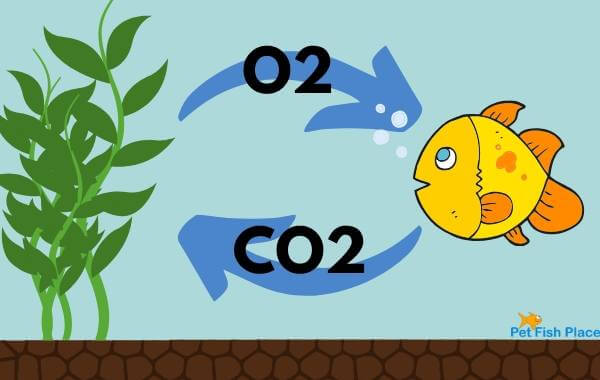
Adding live plants to your set-up will always be a good thing. While creating a more comfortable and natural environment for you fish, live plants also aid in the gas exchange process. Fish take in oxygen (O2) and put out carbon dioxide (CO2) while plants take in carbon dioxide and put out oxygen. How’s that for the perfect set-up? By adding in live plants, you are only helping raise the levels of O2 in the water while simultaneously reducing the amount of CO2.
Sharing is caring!

